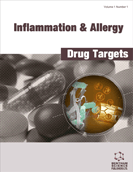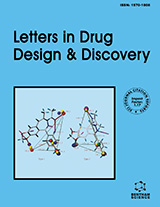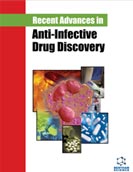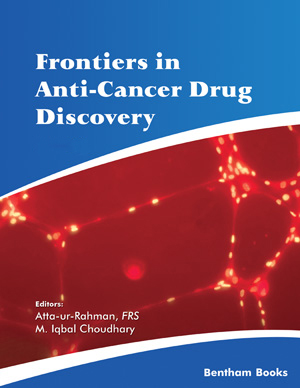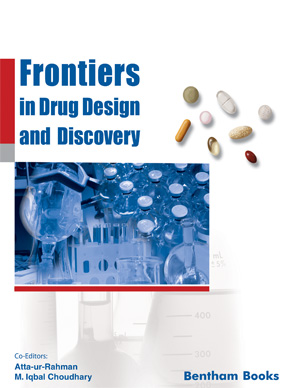Abstract
We have reported the synthesis, characterization, in vitro release profile and preliminary pharmacological investigations of an antioxidant mutual prodrug of diacerein with thymol in our earlier communication. The present work reports the results of in vivo release studies and extensive pharmacological evaluation of this prodrug in collagenase- induced osteoarthritis and monosodium iodoacetate- induced hyperalgesia in Wistar rats. In vivo release was thoroughly studied in Wistar rats upon oral administration of the prodrug. In rat blood, release of 92.7% of diacerein and 20.5% of thymol was observed. From these studies we hypothesized that activation of prodrug could be mediated by physiological pH of blood (7.4) and serum esterases. Pharmacological screening of prodrug in collagenase and monoiodoacetate-induced osteoarthritis at a dose of 6.8 mg/kg, (BID) exhibited significant reduction in knee diameter (p<0.001), increase in paw withdrawal latency (p<0.001), and locomotor activity (p<0.001) with significantly higher anti-inflammatory and anti-osteoarthritic activities as compared to parent drug. The biochemical studies indicated a significant step-up in glucosaminoglycan level (p<0.001) and reduction in the C-reactive protein (p<0.001) and sulfated alkaline phosphatase levels (p<0.001). The histopathological and radiological studies confirmed the additive anti-osteoarthritic effect of prodrug as compared to plain diacerein. Antioxidant potential of prodrug was significantly more (p<0.001) while ulcer index was significantly lower (p<0.01) than diacerein. Interestingly, the diarrhea observed in diacerein- treated animals was not evident in animalstreated with prodrug, thymol and their physical mixture. Our findings indicate promising potential of this antioxidant prodrug to be used for long-term and safer management of OA.
Keywords: Antioxidant, thymol, diacerein, in vivo release kinetics, mutual prodrug, collagenase-induced, monoiodoacetateinduced, osteoarthritis, hyperalgesia.
Graphical Abstract
Inflammation & Allergy - Drug Targets (Discontinued)
Title:Diacerein-Thymol Prodrug: In Vivo Release and Pharmacological Screening in Experimental Models of Osteoarthritis in Wistar Rats
Volume: 13 Issue: 6
Author(s): Dipmala Patil, Suneela Dhaneshwar and Parag Kadam
Affiliation:
Keywords: Antioxidant, thymol, diacerein, in vivo release kinetics, mutual prodrug, collagenase-induced, monoiodoacetateinduced, osteoarthritis, hyperalgesia.
Abstract: We have reported the synthesis, characterization, in vitro release profile and preliminary pharmacological investigations of an antioxidant mutual prodrug of diacerein with thymol in our earlier communication. The present work reports the results of in vivo release studies and extensive pharmacological evaluation of this prodrug in collagenase- induced osteoarthritis and monosodium iodoacetate- induced hyperalgesia in Wistar rats. In vivo release was thoroughly studied in Wistar rats upon oral administration of the prodrug. In rat blood, release of 92.7% of diacerein and 20.5% of thymol was observed. From these studies we hypothesized that activation of prodrug could be mediated by physiological pH of blood (7.4) and serum esterases. Pharmacological screening of prodrug in collagenase and monoiodoacetate-induced osteoarthritis at a dose of 6.8 mg/kg, (BID) exhibited significant reduction in knee diameter (p<0.001), increase in paw withdrawal latency (p<0.001), and locomotor activity (p<0.001) with significantly higher anti-inflammatory and anti-osteoarthritic activities as compared to parent drug. The biochemical studies indicated a significant step-up in glucosaminoglycan level (p<0.001) and reduction in the C-reactive protein (p<0.001) and sulfated alkaline phosphatase levels (p<0.001). The histopathological and radiological studies confirmed the additive anti-osteoarthritic effect of prodrug as compared to plain diacerein. Antioxidant potential of prodrug was significantly more (p<0.001) while ulcer index was significantly lower (p<0.01) than diacerein. Interestingly, the diarrhea observed in diacerein- treated animals was not evident in animalstreated with prodrug, thymol and their physical mixture. Our findings indicate promising potential of this antioxidant prodrug to be used for long-term and safer management of OA.
Export Options
About this article
Cite this article as:
Patil Dipmala, Dhaneshwar Suneela and Kadam Parag, Diacerein-Thymol Prodrug: In Vivo Release and Pharmacological Screening in Experimental Models of Osteoarthritis in Wistar Rats, Inflammation & Allergy - Drug Targets (Discontinued) 2014; 13 (6) . https://dx.doi.org/10.2174/1871528114666150212125600
| DOI https://dx.doi.org/10.2174/1871528114666150212125600 |
Print ISSN 1871-5281 |
| Publisher Name Bentham Science Publisher |
Online ISSN 2212-4055 |
 23
23Related Articles
-
The Many Roles of Chemokine Receptors in Neurodegenerative Disorders: Emerging New Therapeutical Strategies
Current Medicinal Chemistry Advances in Research of Schiff-Base Metal Complexes as Potent Antioxidants
Current Medicinal Chemistry Recent Developments on 1,2,4-Triazole Nucleus in Anticancer Compounds: A Review
Anti-Cancer Agents in Medicinal Chemistry Alzheimers Disease and Non-Steroidal Anti-Inflammatory Drugs: Old Therapeutic Tools with Novel Mechanisms of Action?
Current Medicinal Chemistry - Central Nervous System Agents Recent Progress in Mutation-driven Therapy, Immunotherapy and Combination Therapy for the Treatment of Melanoma
Current Cancer Drug Targets Promising Anti-stroke Signature of Voglibose: Investigation through In- Silico Molecular Docking and Virtual Screening in In-Vivo Animal Studies
Current Gene Therapy The Changing Landscape of Voltage-Gated Calcium Channels in Neurovascular Disorders and in Neurodegenerative Diseases
Current Neuropharmacology Adjudin - A Male Contraceptive with Other Biological Activities
Recent Patents on Endocrine, Metabolic & Immune Drug Discovery (Discontinued) The Role of Image Guided Radiotherapy in the Treatment of Soft Tissue Sarcoma
Current Cancer Therapy Reviews Intraocular Delivery of Anti-Infective Drugs-Bacterial, Viral, Fungal and Parasitic
Recent Patents on Anti-Infective Drug Discovery New Insights on Neuronal Nicotinic Acetylcholine Receptors as Targets for Pain and Inflammation: A Focus on α7 nAChRs
Current Neuropharmacology The Role of Mitogen-Activated Protein Kinases in Asthma
Current Immunology Reviews (Discontinued) Molecule of the Month
Current Topics in Medicinal Chemistry Decreased Vascular Repair and Neovascularization with Ageing: Mechanisms and Clinical Relevance with an Emphasis on Hypoxia- Inducible Factor-1
Current Molecular Medicine A Nanotechnological Approach to the Management of Alzheimer Disease and Type 2 Diabetes
CNS & Neurological Disorders - Drug Targets Understanding the Role of Hypoxia Inducible Factor During Neurodegeneration for New Therapeutics Opportunities
Current Neuropharmacology An Update on Hepatic Stem Cells: Bench to Bedside
Current Pharmaceutical Biotechnology The Rabbit as an Experimental and Production Animal: From Genomics to Proteomics
Current Protein & Peptide Science Stem Cell Therapy for Ischaemic Stroke: Translation from Preclinical Studies to Clinical Treatment
CNS & Neurological Disorders - Drug Targets Therapeutic Potential of Functional MRI in the Squamous Cell Cancer of Head and Neck
Current Medical Imaging


